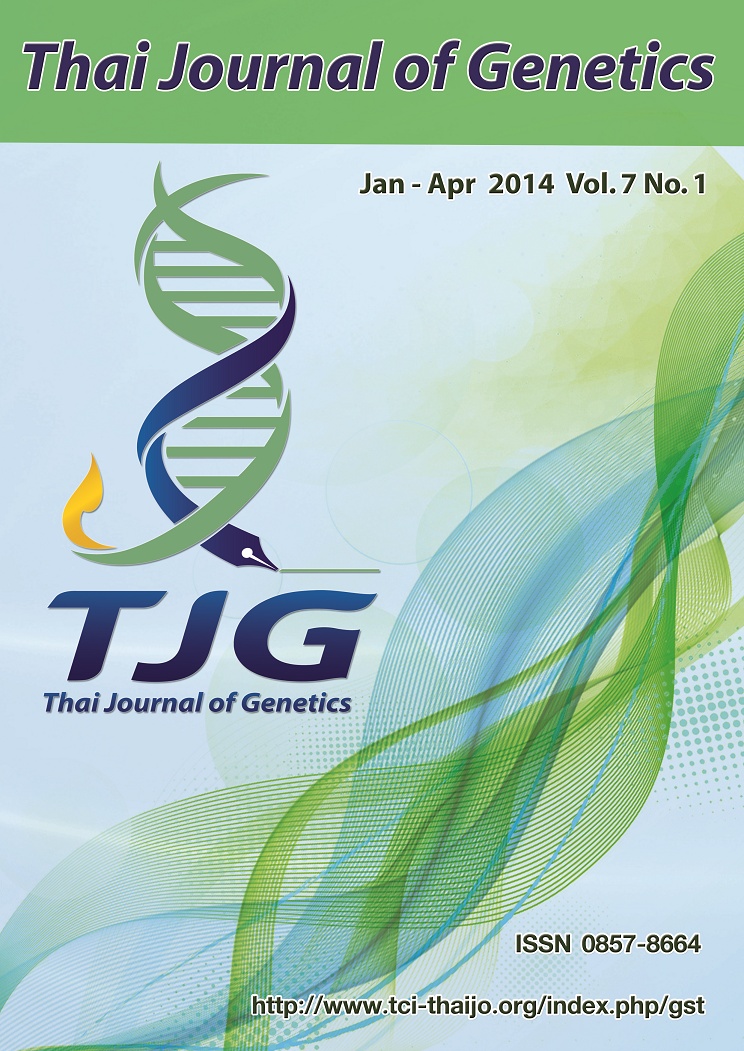การโคลนยีน arsenate reductase และ phytochelatin synthase ที่ตอบสนองต่อสาร หนูในข้าวอินดิกาพันธุ์ขาวดอกมะลิ105(Molecular Cloning of Arsenate reductase and Phytochelatin synthase gene related to arsenic response in Oryza sativa L. var. indica cv. Khao Dawk
DOI:
https://doi.org/10.14456/tjg.2014.10Keywords:
Oryza sativa, Jusmine rice, Arsenic, Arsenate reductase, Phytochelatin synthaseAbstract
สารหนู (arsenic, As) ที่สะสมในพืชเป็นปริมาณสูงจะส่งผลให้เกิดการยับยั้งการเจริญเติบโตของพืชได้ ดังนั้นเมื่อพืชได้รับสารหนูเข้าทางเซลล์ราก จึงเกิดกลไกการลดความเป็นพิษของสารหนูที่เข้าสู่เซลล์พืชด้วยเอนไซม์หลัก คือ arsenate reductase (AR) และ phytochelatin synthase (PCS) งานวิจัยนี้ได้โคลนยีนที่เกี่ยวข้องกับกลไกดังกล่าวจากรากของข้าวพันธุ์ขาวดอกมะลิ105 ที่ได้รับสารหนู โดยพบว่ายีน arsenate reductase ที่โคลนได้ประกอบด้วยนิวคลีโอไทด์ 414 คู่เบส กำหนดการสร้างสายโพลีเปปไทด์ 137 เรสซิดิวส์ ที่ประกอบด้วยลำดับกรดอะมิโนส่วนอนุรักษ์ HisCys(X)5Arg ซึ่งมีหน้าที่สำคัญต่อปฏิกิริยารีดักเทส และพบว่ามีความคล้ายกับ arsenate reductase ที่ได้จากข้าวแอฟริกา (Oryza glaberrima Steud.) นอกจากนี้ยังได้โคลนบางส่วนของยีน phytochelatin synthase ในบริเวณส่วนปลาย 3' ของยีน ขนาด 1,498 คู่เบส ประกอบด้วยยีนขนาด 873 คู่เบส กำหนดการสร้างสายโพลีเปปไทด์ที่มีความยาวกรดอะมิโน 290 เรสซิดิวส์ ลำดับกรดอะมิโนความคล้ายกับ phytochelatin synthase ของข้าวสาลี (Triticum aestivum L.) ทั้งยังพบกรดอะมิโนส่วนอนุรักษ์ CyCys(X)3Cys(X)2Cys บริเวณปลาย C-terminus ซึ่งมีหน้าที่สำคัญในการจับกับโลหะหนักและสารหนู
Accumulation of arsenic (As) in plants can severely inhibit plant growth. Once the arsenic is taken up by roots, arsenic detoxification enzymes such as arsenate reductase (AR) and phytochelatin synthase (PCS) are up-regulated in response to arsenic accumulation. In this study, the two-detoxification enzymes were cloned from roots of arsenic-treated Oryza sativa L. ssp. indica, cv. Khao Dawk Mali 105 (Jasmine rice). The results showed that the AR gene consists of 414 bp encoding a polypeptide with 137 amino acids long. This encoded amino acid sequence contains the consensus motif HisCys(X)5Arg that is essential for reductase activity and is similar to the arsenate reductase polypeptide from African rice (Oryza glaberrima Steud.). Moreover, the partial phytochelatin synthase gene at 3' end, 1,498 bp containing 873 coding sequence, was successfully cloned. The obtained phytochelatin synthase gene encoding for a 290 amino acid polypeptide was highly related to phytochelatin synthase from Triticum aestivum L. The deduced amino acid sequence contained consensus motif CysCys(X)3Cys(X)2Cys at C-terminal which serves as a sensor for heavy metal ions and arsenic.
References
Chang YH, Cong H, Li Y, Lin J, Sheng BL (2012) Characterization and expression of a phytochelatin synthase gene in Birch-leaf Pear (Pyrus betulaefolia Bunge). Plant Mol Biol 30: 1329–1337.
Cobbett C, Goldsbrough P (2002) Phytochelatins and metallothioneins: roles in heavy metal detoxification and homeostasis. Annu Rev Plant Biol 53: 159–182.
Dhankher OP, Rosen BP, McKinney EC, Meagher RB (2006) Hyperaccumulation of arsenic in the shoots of Arabidopsis silenced for arsenate reductase, ACR2. Proc Natl Acad Sci USA 103: 5413–5418.
Duan GL, Zhu YJ, Tong YP, Cai C, Kneer R (2005) Characterization of arsenate reductase in the extract of roots and fronds of Chinese brake fern, an arsenic hyperaccumulator. Plant Physiol 138: 461–469.
Ghosh M, Shen J, Rosen BP (1999) Pathways of As (III) detoxification in Saccharomyces cerevisiae. Proc Natl Acad Sci USA 96: 5001–5006.
Ha S, Smith AP, Howden R, Dietrich WM, Bugg S, O’Connell MJ, Goldsbrough PB, Cobbett CS (1999) Phytochelatin synthase genes from Arabidopsis and the yeast Schizosaccharo-myces pombe. Plant Cell 11: 1153–1163.
May MJ, Vernoux T, Leaver C, Montagu M, Inze D (1998) Glutathione homeostasis in plants: implications for environmental sensing and plant development. J Exp Bot 49: 649–667.
Meharg A (2004) Arsenic in rice-understanding a new disaster for South-East Asia. Trends Plant Sci 9: 415–417.
Meharg A, Sun G, Williams PN, Adomako E, Deacon C, Zhu YG (2008) Inorganic arsenic levels in baby rice are of concern. Environ Pollut 152: 746–749.
Mukhopadhyay R, Shi J, Rosen BP (2000) Purification and characterization of Acr2p, the Saccharomyces cerevisiae arsenate reductase. J Biol Chem 275: 21149–21157.
Mukhopadhyay R, Rosen BP (2001) The phosphatase C(X)5R motif is required for catalytic activity of the Saccharomyces cerevisiae Acr2p arsenate reductase. J Biol Chem 276: 34738–34742.
Mukhopadhyay R, Rosen BP (2002) Arsenate reductases in prokaryotes and eukaryotes. Environ Health Perspect 110: 745–748.
Nocito FF, Lancilli C, Crema B, Fourcroy P, Davidian
J, Sacchi GA (2006) Heavy metal stress and sulphate uptake in maize roots. Plant Physiol 141: 1138–1148.
Radabaugh TR, Aposhian HV (2000) Enzymatic reduction of arsenic compounds in mammalian systems: reduction of arsenate to arsenite by human liver arsenate reductase. Chem Res Toxicol 13: 26–30.
Ruotolo R, Peracchi A, Bolchi A, Infusini G, Amoresano A, Ottonello S (2004) Domain organization of phytochelatin synthase. J Biol Chem 279: 14686–14693.
Tamura K, Dudley J, Nei M, Kumar S (2007) MEGA4: Molecular Evolutionary Genetics Analysis (MEGA) Software Version 4.0. Mol Biol Evol 24: 1596–1599.
Vestergaard M, Matsumoto S, Nishikori S, Shiraki K, Hirata K, Takagi M (2008) Chelation of cadmium ions by phytochelatin synthase: role of the cystein-rich C-terminal. Anal Sci 24: 277–281.
Sambrook J, Russell DW (2001) Molecular cloning: A laboratory manual. 3rd ed. Cold Spring Harbor Laboratory Press, New York.
Sharma SS, Dietz K (2008) The relationship between metal toxicity and cellular redox imbalance. Trends Plant Sci 14: 43–50.
Wargar A, Isayenkov SV, Maathuis FJM, Zhao FJ (2009) Arsenite transport in plants. Cell Mol Life Sci 66: 2329–2339.
Zhao FJ, Ma JF, Meharg A, McGrath SP (2008) Arsenic uptake and metabolism in plants. New Phytol 181: 777–789.
Zhou Y, Messier N, Ouellette M, Rosen BP, Mukhopadhyay R (2004) Leishmania major LmACR2 is a pentavalent antimony reductase that confers sensitivity to the drug Pentostam. J Biol Chem 279: 37445–37451.



